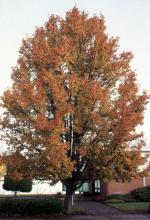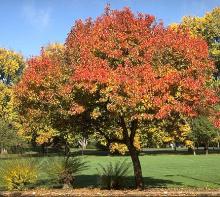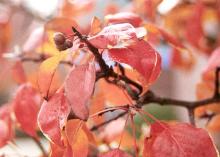Pyrus calleryana
Common name:
Callery Pear
Pronunciation:
PI-rus kal-er-ee-A-na
Family:
Rosaceae
Genus:
Type:
Broadleaf
Native to (or naturalized in) Oregon:
No
- Broadleaf, deciduous tree, 30-40 ft (9-12 m), variable forms. Trunk bark is lightly furrowed and grayish brown at maturity. Note spurs shoots on branches. Leaves are alternate, simple, leathery, and lustrous dark green. Foliage can develop a spectacular reddish-purple in fall. Flowers white, borne in 7.5 cm clusters (cymes); they produce a strong, rancid odor. Fruit small, rounded, 10-15 mm across, russet-dotted, inedible.
- Sun. Very adaptable to many different soils; tolerates drying and pollution
- Hardy to USDA Zone (5)6 , some cultivars listed as hardy to Zone 4 Species native to China, Viet Nam, Japan, and Korea.
- Considered invasive. Callery pear is reported as established outside cultivation in 25 states in the United States, sometimes forming dense thickets. The small fruit are eaten by birds that then disperse the viable seeds beyond the original area. The resulting plants are wild-growing descendants of multiple genotypes, originating in part from introduced cultivars. At lease two states have banned the sale of Callery pear, and the rulings go into effect in 2-3 years. Note: "The species cannot self-pollinate because of a self-incompatibility system, but recent fruit set is due to crossing between different cultivars or between the scion and rootstock of cultivated individuals. Consequently, individual cultivars themselves are not invasive, but the combination of cultivars within an area creates a situation in which invasive plants can be produced. " see https://academic.oup.com/bioscience/article/57/11/956/234351?login=false
-
Cultivars are more commonly planted than the species
- Aristocrat™ - leaves narrow, glossy, purple-red to orange fall color. Narrow branch angles, fast growing and pyramidal. Susceptible to fireblight, USDA Zone 4b.
- ‘Autumn Blaze’ - horizontal branches from a broad crown. Develops fall color early, but it is variable; can be bright red. Reportedly cold hardy to USDA Zone 4. Selected at Oregon State University by Mel Westwood.
- ‘Bradford’ - the original introduction and for some time the "standard", it has several positive features, for example its flowers appear before leaves emege and thus more showy than several other cultivars. However, it reportedly has a tendency to split with age (see Dirr, 1998, for a good discussion). It was raised from seed purchased in China in 1919 and introduced and named in 1963 by the USDA.
- ‘Capital’ - glossy leaves, forms a narrow crown (columnar), purple-red to bronze fall color, thornless, and fireblight resistant.
- Chanticleer® (syn. ‘Select’, ‘Cleveland Select’ ‘Glen's Form’) - upright, narrow columnar form, but apparently more than one clone since some are more columnar than others, reddish fall color, USDA Zone 4.
- ‘Redspire’ - pyramidal form, symmetrical, formal, fall color yellow to red, reportedly goes dormant earlier in fall.
- calleryana: after Joseph M. M. Callery (1810-1862). A French-Italian sinologist, missionary and botanical collector. Born in Turin, Italy and educated in France. In 1835 he joined the Missions Etrangères, an organization dedicated to missionary work in foreign lands. He spent several years in China as missionary and later as a French administration official. He presented some 2,000 plant species (about 15 were new to science) to the Paris Museum of Natural History. This included the pear species ultimately named in his honor, Pyrus calleryana.
- Oregon State Univ. campus: southwest Burt Hall (‘Bradford’), northwest Cordley Hall (‘Autumn Blaze’).











